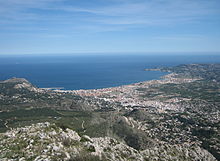Costa Blanca
Costa Blanca ( Catalan / Spanish for white coast ') referred tourism geographically the coastline of the Spanish province of Alicante , specifically from Dénia in the north to Pilar de la Horadada in the south.
Surname
The name Costa Blanca was created by tourism managers in the 1950s . On the one hand it alludes to the houses traditionally painted white, and on the other hand to the lighting conditions that make the sand appear white. The contrast between the blue sea and the bright coast can also be found in the blue and white flag of the province of Alicante ( City of Light ), to which the Costa Blanca largely belongs. It is also sometimes referred to as the Gulf of Alicante or Bay of Alicante . The Costa Cálida joins in the south , the Mar Menor is counted on both coasts depending on the source.
Climate and tourism
The Costa Blanca is a popular holiday destination for tourists from Spain and across Europe because of its mild Mediterranean climate. Many Germans have settled in this part of Spain since the 1950s. For some Germans with a Nazi past, there was an ideal shelter there, as Franco guaranteed them an inconspicuous life with protection from international criminal prosecution (source Spiegel 42, 2005). After the death of Franco and with the democratization of the country, the region experienced an economic upswing in the tourism industry, which continues to this day - apart from occasional smaller slumps. The Costa Blanca is therefore one of the engines of the Spanish economy today. With tourism, so did the construction volume, which made the region the largest construction site in Europe. The region already has 13 golf courses with adjacent urbanizations with sizes of up to twenty thousand residential units. Another 52 golf courses are being planned. In the past year, permits were issued for the construction of 70,000 projects, a slump is not yet in sight, although fewer and fewer customers can be found who are willing to pay the significantly increased prices for a property. In addition to tourists from Germany, Spaniards from Madrid also like to travel to the Costa Blanca because it is the closest coast to the capital. It is becoming increasingly noticeable that other wealthy buyers, primarily from Eastern Europe, are settling on the Costa Blanca. Proof of this is the Russian Orthodox Church below the noble urbanization Altea Hills.
With the appreciation of the British pound and the expansion of flight connections to England, the coast also became more accessible to the simpler English public, who mainly cavort in lively Benidorm.
Among the most famous excursion destinations are the amusement parks Terra Mítica , Mundo Mar and Terra Natura . In Valencia there is the Ciutat de les Arts i les Ciències , the City of Arts and Sciences, a futuristic project with a science museum, planetarium and water park. Plays, concerts and operas are performed in the adjoining art palace.
The small villages in the hinterland are also definitely worth seeing. Many of the villages have still retained their Spanish origins, other villages that are closer to the coast have not been spared from holiday resorts and luxury apartments. Nevertheless, the villages of Jalon, Lliber, Alcalali, Parcent, Murla, Castell de Castels, Guadalest and many others are particularly worth a visit.
When visiting the white coast, every visitor can inquire about the hinterland and various possibilities for excursions in tourist information offices, which are easy to find in every major town. In the mountains of Jalon, in Les Murtes, there is a German-run donkey stud that works to save and preserve the giant Andalusian donkeys, which are threatened with extinction. However, a commercial interest cannot be ruled out here either with the operators.
The village of Jalon, or Xaló, in Valencian , is known for its wines, raisins and almond products, as well as for its embutidos , air-dried sausages. Every Saturday morning there is a huge international flea market where all sorts of cheap stuff is sold to the predominantly older buyers. According to the stories, when the Jalón flea market started, a Madrilene must have bought a very valuable painting for little money. Since this reporting, which has spread like wildfire all over Spain, this flea market continues to grow.
There are few accommodation options in these villages, so that one is bound to the large hotels on the coast. These few accommodation options are fully booked for months. With a little luck you can find some on the way from Jalon to Benissa.
In the municipality of Lliber there is an international school under English management. Your offer for English-language lessons is accepted not only by native English speakers, but also by Spaniards, Germans and members of other nationalities.
An idyllically situated excursion destination is the ruins of the Preventori d'Aigües , a former luxury spa hotel and later tuberculosis sanatorium near Alicante.
To the south of Alicante, the fishing port of Santa Pola with the offshore island of Tabarca , the world heritage city of Elche , the episcopal city of Orihuela and the city of Torrevieja are tourist attractions.
Known places
gallery
proof
- ^ Breuer, Toni (1982): Spain. 1. A., p. 213.
- ^ Fründt, Hans-Jürgen (2009): Costa Blanca. 4. A., p. 77.
Coordinates: 38 ° 21 ′ 14 " N , 0 ° 24 ′ 29" W.













